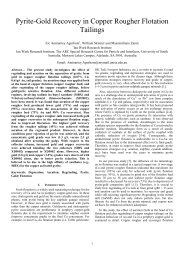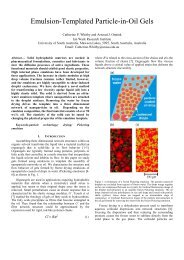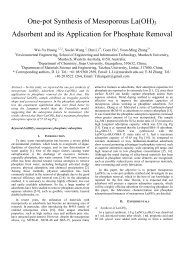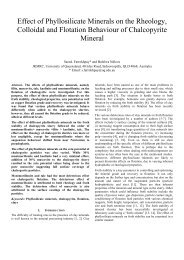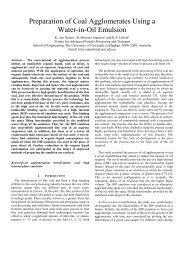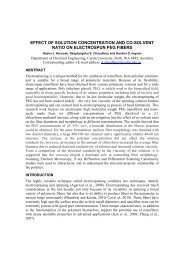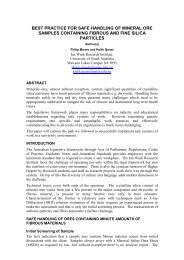the development of high temperature water-gas shift catalysts for ...
the development of high temperature water-gas shift catalysts for ...
the development of high temperature water-gas shift catalysts for ...
- No tags were found...
Create successful ePaper yourself
Turn your PDF publications into a flip-book with our unique Google optimized e-Paper software.
Chemeca 2011, Sydney, NSW, Australia<br />
18−21 September, 2011<br />
THE DEVELOPMENT OF HIGH TEMPERATURE WATER-GAS SHIFT<br />
CATALYSTS FOR PRODUCTION OF HYDROGEN FROM SIMULATED COAL-<br />
DERIVED SYNGAS<br />
Y Sun a* , S S Hla b , G J Duffy a , A Cousins b , D French c , L Morpeth b , J H Edwards a<br />
and D G Roberts b<br />
Introduction<br />
a<br />
CSIRO Energy Technology, PO Box 330, Newcastle 2300, Australia<br />
b<br />
CSIRO Energy Technology, PO Box 883, Pullenvale, QLD 4069, Australia<br />
c CSIRO Energy Technology, PO Box 52, North Ryde, NSW 1670 Australia<br />
*Corresponding author. Tel.: +61 2 4960 6106; fax: +61 2 4960 6111<br />
E-mail address: yanping.sun@csiro.au<br />
Integrated Gasification Combined Cycle (IGCC) with CO 2 capture is one <strong>of</strong> <strong>the</strong> key clean coal technologies.<br />
However, <strong>high</strong> capital and operating costs currently prevent widespread implementation <strong>of</strong> <strong>the</strong> technology. Novel<br />
<strong>water</strong>-<strong>gas</strong> <strong>shift</strong> technology that integrates a <strong>high</strong> <strong>temperature</strong> <strong>water</strong>-<strong>gas</strong> <strong>shift</strong> (HT-WGS) catalyst with an efficient<br />
and cost-effective membrane <strong>for</strong> in-situ separation <strong>of</strong> product H 2 or CO 2 to drive <strong>the</strong> equilibrium-limited WGS<br />
reaction to <strong>the</strong> right (Eq. 1) has <strong>the</strong> benefit <strong>of</strong> potentially achieving total conversion <strong>of</strong> CO and reducing <strong>the</strong> costs<br />
<strong>of</strong> CO 2 capture:<br />
CO + H 2 O (g) ↔ H 2 + CO 2 ∆H° 25°C = − 41 kJ/mol (1)<br />
It is more efficient to operate a catalytic membrane reactor (CMR) at <strong>high</strong> <strong>temperature</strong> because <strong>high</strong> <strong>temperature</strong><br />
results in faster reaction rates which lead to <strong>high</strong> H 2 yield. Fur<strong>the</strong>rmore, operation <strong>of</strong> a CMR at <strong>high</strong> <strong>temperature</strong><br />
could reduce <strong>the</strong> need <strong>for</strong> cooling <strong>the</strong> <strong>high</strong> <strong>temperature</strong> syn<strong>the</strong>sis <strong>gas</strong> leaving a <strong>gas</strong>ifier prior to <strong>shift</strong>ing, <strong>the</strong>reby<br />
conserving energy. However, no existing commercial WGS <strong>catalysts</strong> can be operated at <strong>temperature</strong>s greater than<br />
450°C.<br />
In <strong>the</strong> present work, three types <strong>of</strong> HT-WGS <strong>catalysts</strong> were designed and tested <strong>for</strong> <strong>the</strong> WGS reaction in <strong>the</strong><br />
<strong>temperature</strong> range 450 to 600°C and 1 atm in simulated coal-derived syn<strong>gas</strong>. In addition, a variety <strong>of</strong> catalyst<br />
characterisation studies was carried out in an attempt to clarify <strong>the</strong> reaction mechanism <strong>of</strong> <strong>the</strong> WGS reaction over<br />
<strong>the</strong>se <strong>catalysts</strong>. The results provide valuable insight into <strong>the</strong> activity and stability <strong>of</strong> <strong>the</strong>se <strong>catalysts</strong>, which could<br />
be applied to <strong>the</strong> design and <strong>development</strong> <strong>of</strong> novel, <strong>high</strong>ly active and stable HT-WGS <strong>catalysts</strong> <strong>for</strong> use in WGS<br />
membrane reactors.<br />
HT-WGS catalyst design and <strong>for</strong>mula<br />
Cu and Fe were chosen as active metals in HT-WGS <strong>catalysts</strong> because Cu and Fe have good activity <strong>for</strong> <strong>the</strong> WGS<br />
reaction at low and moderately <strong>high</strong> <strong>temperature</strong>s. However, <strong>the</strong>y are prone to sintering at <strong>high</strong> <strong>temperature</strong>s and<br />
Fe 2 O 3 tends to be over-reduced to FeO or Fe under HT-WGS reaction conditions, which is inactive <strong>for</strong> <strong>the</strong> WGS<br />
reaction. There<strong>for</strong>e, <strong>the</strong> major challenge in developing novel HT-WGS <strong>catalysts</strong> is to design a refractory oxide<br />
which is able to stabilize Cu and Fe at <strong>temperature</strong>s greater than 500°C.<br />
The redox oxide CeO 2 was chosen as <strong>the</strong> main catalyst support <strong>for</strong> <strong>the</strong> HT-WGS <strong>catalysts</strong> due to its <strong>high</strong> oxygen<br />
storage capacity (OSC), <strong>high</strong> oxygen mobility and facile reducibility, which means that it can act as an oxidant to<br />
participate in <strong>the</strong> WGS reaction. The introduction <strong>of</strong> La 2 O 3 , ZrO 2 or Al 2 O 3 into CeO 2 can improve its <strong>the</strong>rmal<br />
stability, oxygen storage capacity and increase metal dispersion, thus improving its catalytic activity (Kaspar et al<br />
1999). In addition, oxides with a perovskite structure (ABO 3 ) are ano<strong>the</strong>r alternative as catalyst support due to<br />
<strong>the</strong>ir <strong>high</strong> stability, <strong>high</strong> redox property, and ability to control acid-base properties (Pena et al 2001). Hence,<br />
mixed redox metal oxides and perovskite-like oxides were selected as catalyst supports <strong>for</strong> <strong>the</strong> novel Cu- and Fecontaining<br />
<strong>catalysts</strong>. Based on <strong>the</strong> above rationale, a number <strong>of</strong> novel HT-WGS catalyst <strong>for</strong>mulations were<br />
designed and are listed in Table 1.<br />
Table 1 The <strong>for</strong>mula <strong>of</strong> HT-WGS <strong>catalysts</strong>
Yanping Sun et al, Chemeca 2011<br />
She has attended numerous national and international conferences and published one US patent and 32 academic<br />
and conference papers.<br />
4



